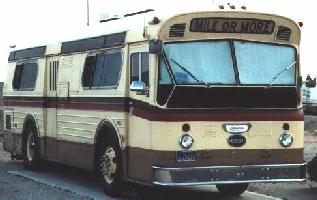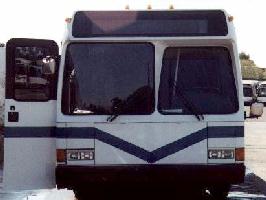![]() hile interesting reading, this item is a waste of time for anyone planning to spend over $100,000 on their conversion. However, if you have to stay well below $50,000 and plan to do the work yourself while raising a family, it could easily make the difference between success and failure. I believe our coach was the best investment we made in our children's
development. They have seen the oceans and the mountains many times, swam in the Great Lakes, seen the actual hardware of our space program, observed pioneer life in places like Cades Cove, etc. etc. While most people want it for several reasons, this article is aimed at the person wanting to travel with his family in reasonable comfort at the lowest practical cost.
hile interesting reading, this item is a waste of time for anyone planning to spend over $100,000 on their conversion. However, if you have to stay well below $50,000 and plan to do the work yourself while raising a family, it could easily make the difference between success and failure. I believe our coach was the best investment we made in our children's
development. They have seen the oceans and the mountains many times, swam in the Great Lakes, seen the actual hardware of our space program, observed pioneer life in places like Cades Cove, etc. etc. While most people want it for several reasons, this article is aimed at the person wanting to travel with his family in reasonable comfort at the lowest practical cost.
Back in 1967 when I first got interested in coaching, both motor homes and coach conversions cost about the same as a luxury car. Today most conversions cost about the same as a luxury house. The main difference is that there are so many things that we didn't have then that are now considered "standard equipment." However, it is still possible to convert a coach for a cost within reach of many families. I'm talking about a final product that is up from a tent or travel trailer, not down from San Simeon.
While building a converted coach is never cheap, I believe it is possible to build a reasonable conversion in the area of $20-25,000 and a year or two of reasonably dedicated family effort. This would be a do-it-yourself project and assumes some skill and available tools for the crafts involved. If cost is the major consideration, I think $10,000 is about as low as you can go and still get a road worthy conversion.
 We have seen many other families convert a coach while raising their children. We have also seen some fail. I have tried to identify the differences between the two groups, and have come to the conclusions discussed here. Cost involves both dollars and time, with time being the major stumbling point. A person with a full time job and a family to take care of simply can't put in near as much time on a coach as a retiree or someone who does conversions for a living. The fact that you are converting a coach does not make other family obligations go away. People
with full time jobs are free-time poor. Add the responsibilities of
children and taking care of a house and you are free-time impoverished. Failure to grasp this is a main cause of failure. I fell into the trap of not realizing that just having the skill to do a first class job is not enough. I didn't have enough time. Twenty years after I started, one area still had a bare wall awaiting the cabinet.
We have seen many other families convert a coach while raising their children. We have also seen some fail. I have tried to identify the differences between the two groups, and have come to the conclusions discussed here. Cost involves both dollars and time, with time being the major stumbling point. A person with a full time job and a family to take care of simply can't put in near as much time on a coach as a retiree or someone who does conversions for a living. The fact that you are converting a coach does not make other family obligations go away. People
with full time jobs are free-time poor. Add the responsibilities of
children and taking care of a house and you are free-time impoverished. Failure to grasp this is a main cause of failure. I fell into the trap of not realizing that just having the skill to do a first class job is not enough. I didn't have enough time. Twenty years after I started, one area still had a bare wall awaiting the cabinet.
Once one gets the cost in time and money in line, reliability is the next key issue. If your goal is to travel with a family and complete the trips in your available vacation time, you need a coach that will probably not break down. If it does, you must be able to get parts and service quickly, anywhere in the country. This generally means that newer is much better than older.
 People who have the money to buy all quality components and to hire a commercial converter need a set of philosophies that is totally different from someone on a limited budget. The basic approach to how one can best build a conversion varies greatly with the available cash. As I said, I
think $10,000 is about the bottom. Doubling that gives more flexibility
and opens many options. Double again to $40,000 and the basic philosophies change. Every time you redouble they change again. The point is to adopt a set of rules that fit what you have to spend and not be taken in by what people who have much more money consider essential.
People who have the money to buy all quality components and to hire a commercial converter need a set of philosophies that is totally different from someone on a limited budget. The basic approach to how one can best build a conversion varies greatly with the available cash. As I said, I
think $10,000 is about the bottom. Doubling that gives more flexibility
and opens many options. Double again to $40,000 and the basic philosophies change. Every time you redouble they change again. The point is to adopt a set of rules that fit what you have to spend and not be taken in by what people who have much more money consider essential.
Based on my own experience and that of many other families I have known, I think the basic rules/philosophies/principles for a successful conversion in the $10- 40,000 range are:
1. Know, and stay within, your resource limitations. Don't bite off more than you can chew.
2. Keep the goal of safe comfortable family travel, and what you need to accomplish that, clearly in mind.
3. Do it for yourself and your family, not someone who might buy it 20 years form now. Forget about what many converters hold as a basic tenant of the faith, namely "Make sure you can get your money out when you sell". By forgetting about ever recovering your investment, you can do what is "adequate," instead of expending the resources required to make the coach "saleable." A conversion designed to be saleable will cost two to three times as much to build as one with the same capability that is designed to fill the owners traveling needs.
4. The next basic principle for a successful family built conversion on a limited time/money budget is to quickly get the coach usable, and to use it. The primary reason for this is to keep family interested in the project. A more subtle aspect of this is that once you are at this point, you have succeeded. You are the owner of a functioning converted coach, not just a guy with a project in the side yard. Another reason to use the coach is that vehicles deteriorate rapidly while sitting for an extended period.
5. Get a reliable shell. You need a coach that will probably not break down, but if it does, you must be able to get parts and service quickly, anywhere in the country. This generally means that newer is much better than older. Finding parts for older coaches and making repairs can eat your available time and money, keeping you away from the converting effort.
6. Buy a shell that is ready to go. Extensive modifications and repairs can keep you at home for years.
7. KISS - Keep it Simple Stupid. Fancy complex things eat time and money. The simple cabinets I will put in my next coach will take one tenth the time and money it would take for hand made raised panel doors with a quality finish. Mine will be more durable.
I don't think most people realize the magnitude of what it means to fail at a project this size. There are hundreds, possibly thousands, of coaches across the country that someone started to convert, but they lost interest after four or five years. They all say the same thing. They just want to get their money out, and are willing to forget the work they invested. In reality, their shell has depreciated and deteriorated. One can now get the same model for about half of what they paid. The appliances that are available to you are the same as in the ones found in the newer models, and the warranties on theirs have expired. The work they did may need redone to code or undone to change the basic floor plan. They are stuck with something no one wants. Probably the primary root cause for this loss of their total investment was their determination to build a quality coach that would ensure they recovered their investment when they sold it. Note: I have yet to meet anyone who has recovered his investment in any coach when he sold.
 Low cost conversions start with low cost shells. The lowest cost shell being the school bus. Much nicer, but not much more expensive, is the transit. Fifteen to twenty year old transits are available between $5,000 and $10,000. These have the same engines as the highway coaches and usually have automatic transmissions and power steering. A highway coach about 15 years old in reasonable condition will cost well over $50,000.
Low cost conversions start with low cost shells. The lowest cost shell being the school bus. Much nicer, but not much more expensive, is the transit. Fifteen to twenty year old transits are available between $5,000 and $10,000. These have the same engines as the highway coaches and usually have automatic transmissions and power steering. A highway coach about 15 years old in reasonable condition will cost well over $50,000.
There is no reason a simple conversion like the ones built in the 60's and 70's can't be built today. Identify and do those things you consider essential. The plumbing and LPG could be examples. The next step is to gather up some temporary items (cots, day bed, chairs, couch, table, chest-of-drawers, etc.) and install them securely. Congratulations, you have succeeded in converting a coach. Get a license and insurance, and hit the road. There is no intention that this should be the final product, but you will have become a coaching family. All work from this point on is refinement. The more time you can spend, the faster the rest will go. The key factor is that you have as much time as it takes, even if it's over twenty years, as it did for us.
George Myers is a retired 32 year veteran Electrical Engineer with over twenty years of experience working on bus conversions. George writes a monthly feature article for Bus Conversions Magazine entitled "Electrical Shorts".
